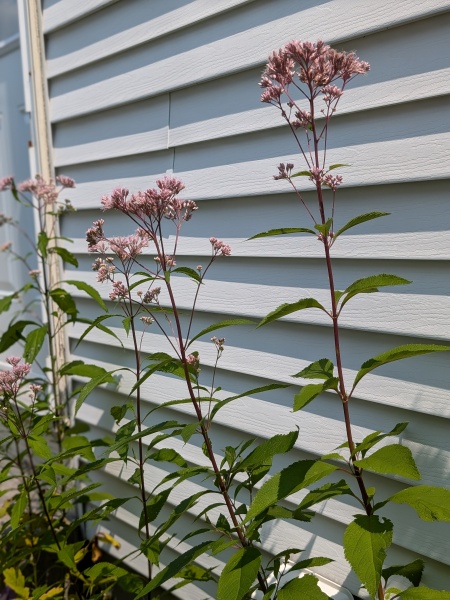Notice: We do not accept seeds that were given before 2025 as they were in fact Spotted Joe-Pye-weed (Eutrochium maculatum).

Source: Donna Bos
Eutrochium purpureum
Sweet Purple Joe Pye Weed
Eupatoire pourpre
Synonyms
green-stemmed Joe-Pye-weed
purple-jointed Joe-Pye-weed
purple-node Joe-Pye-weed
sweet Joe-Pye-weed
sweet-scented Joe-Pye-weed
eupatoire d'eau rouge
Seeds in stock
Available at table Shade
Available at table Shade
We currently accept seeds for this plant
Bloom Colour: Pink
Bloom Period: Jul - Sep
Max Height: 7.0 feet
Max Width: 4.0 feet (spreads by rhizome)
Light Condition:
 Less than 2 or 3 hours of direct sun a day
Soil conditions:
Less than 2 or 3 hours of direct sun a day
Soil conditions:
 Tolerates medium soil condition
Tolerates medium soil condition
 Less than 2 or 3 hours of direct sun a day
Less than 2 or 3 hours of direct sun a day
 Tolerates medium soil condition
Tolerates medium soil condition
Lifespan:
Perennial
plants that will that come back year after year
Gardener Experience:
 Suitable for beginner gardeners
Suitable for beginner gardeners
 Does not spread uncontrollably
Does not spread uncontrollably
 Self-seeding
Self-seeding
 Suitable for beginner gardeners
Suitable for beginner gardeners
 Does not spread uncontrollably
Does not spread uncontrollably
 Self-seeding
Self-seeding
Landscape Uses:
 Suitable for shoreline rehabilitation
Suitable for shoreline rehabilitation
 Suitable for school gardens
Suitable for school gardens
 Suitable for woodland gardens
Suitable for woodland gardens
 Suitable for shoreline rehabilitation
Suitable for shoreline rehabilitation
 Suitable for school gardens
Suitable for school gardens
 Suitable for woodland gardens
Suitable for woodland gardens
Ecological Benefits:
 Supports hummingbirds
Supports hummingbirds
 Supports pollinators
Supports pollinators
 Butterfly host
Butterfly host
 Supports hummingbirds
Supports hummingbirds
 Supports pollinators
Supports pollinators
 Butterfly host
Butterfly host
Tolerates:
 Deer resistant
Deer resistant
 Rabbit resistant
Rabbit resistant
 Tolerates limestone conditions
Tolerates limestone conditions
 Tolerates sandy conditions
Tolerates sandy conditions
 Tolerates juglone conditions
Tolerates juglone conditions
 Deer resistant
Deer resistant
 Rabbit resistant
Rabbit resistant
 Tolerates limestone conditions
Tolerates limestone conditions
 Tolerates sandy conditions
Tolerates sandy conditions
 Tolerates juglone conditions
Tolerates juglone conditions
Special Features and Considerations:
Plant Location
Distribution according to VASCAN

Ephemeral
Native
Introduced
Excluded
Extirpated
Doubtful
Absent
Thrives in Ecozones
- Boreal Plains
- Mixed Wood Plains
Ecological Benefits
Butterflies Supported by Eutrochium purpureum
No butterfly data available for this plant.
Specialized Bees Supported by Eutrochium purpureum
No bee data available for this plant.
Plants that grow in similar conditions, that bloom at the same time.
Complementary Plants
- Bromus pubescens
Hairy Woodland Brome
Brome pubescent - Nabalus altissimus
Tall Rattlesnakeroot
Prenanthe élevée - Scrophularia lanceolata
Lance-leaved Figwort
Scrofulaire lancéolée - Verbena urticifolia
White Vervain
Verveine à feuilles d'ortie - Verbesina alternifolia
Wingstem
Verbésine à feuilles alternes
Substitute For Non-Native Plants
- Sorbaria sorbifolia (False spirea)
- Aruncus dioicus (Goat's Beard)
- Polygonatum odoratum (Solomon's Seal)
- Aegopodium podagraria (Goutweed)
- Thalictrum (Non-Native Meadow Rue)
- Symphiotrichum (Non-Native Aster)
Sowing Information
Download Seed Envelope Labels (PDF)
- Sowing depth: Sow just below surface
- Sow by March
- Stratification duration: 30 days
- Self-seeding
Harvesting and Seed Sharing
- Harvest start month: August
- Harvesting indicator:
- Seeds have become fluffy and can be easily removed by shaking on gently pulling off from stem
- Harvesting:
- Shake seed head in paper bag
- Seed viability test:
- No test needed before donating
- Packaging measure: 1 rounded 1/4 teaspoon
- Seed storage:
- Air dry in paper bag or open container, for a few days until crisp
- Shake seeds to move them once in a while to prevent molding
- Cultivar: Yes, do not donate unless you know source, and there are no known cultivars in your garden or at proximity
- No harvesting video available at this time.
Toxicity Notes
Not likely toxic to mammals.


 Canadensis
Canadensis
